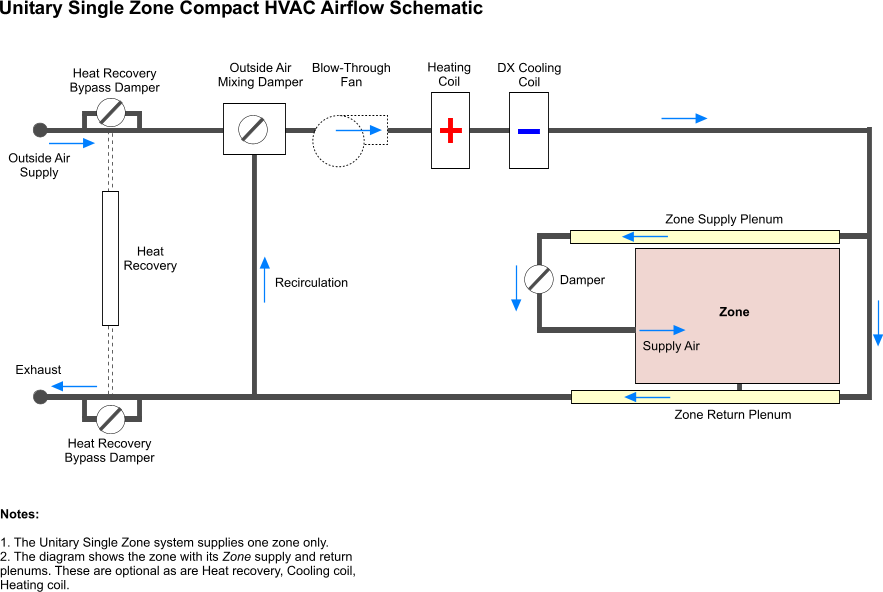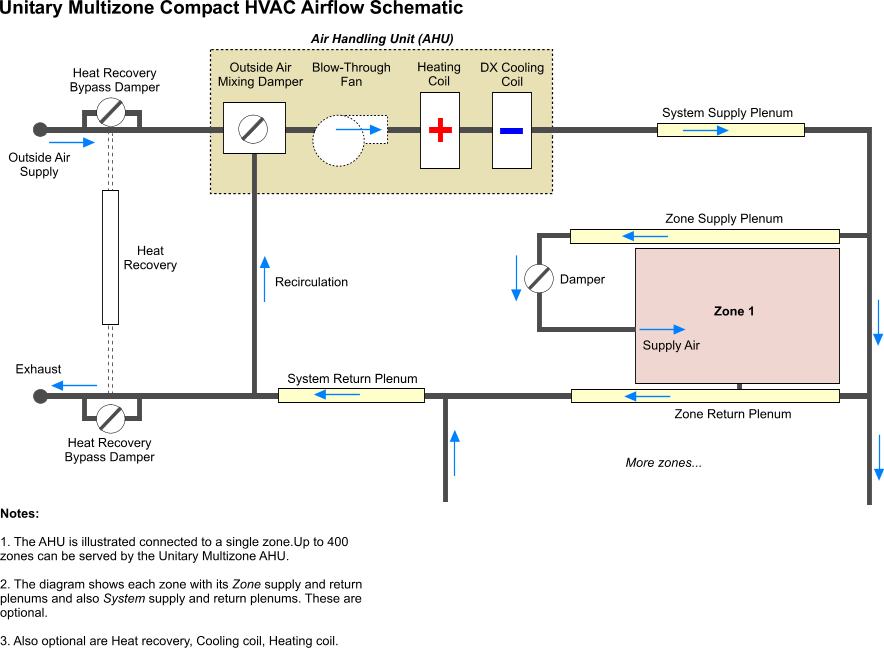
HVAC tab in model data - Compact HVAC
DesignBuilder Compact HVAC provides 2 types of unitary system:
These are described below.
The Unitary single zone option allows you to model simple single constant volume direct-expansion (DX) based HVAC configurations with several different heating options. Direct expansion includes single packaged rooftop systems commonly seen in commercial buildings and split systems commonly seen in residential buildings. In this system, local cooling coils are used to condition air which is supplied to the zone through a local air delivery system. Air delivery can be set up to ensure minimum fresh air supply and there are options for economisers to provide free cooling and heat recovery.
Note: With Unitary single zone systems each zone has its own 'AHU' and so, unlike the Unitary multizone, CAV and VAV Compact HVAC types, Unitary single zone systems take all their data from the zone level.
You can model unitary single zone systems with or without outside air. If you include Air distribution with your Unitary single zone system then heating and cooling will only operate when the Air distribution operation schedule is on.
If you do not want to include outside air in your system, you should uncheck the Mechanical ventilation 'On' check box. In this case heating/cooling availability is determined entirely from the heating/cooling operation schedules under the Heating and Cooling headers.

The Unitary multizone option allows you to model constant volume direct-expansion (DX) based HVAC configurations with several different heating options. Direct expansion (DX) includes single packaged rooftop systems commonly seen in commercial buildings and split systems commonly seen in residential buildings. In this system, central heating and cooling coils are used to condition air which is delivered to the each of the zones in the system through an air delivery system. Air delivery can be set up to ensure minimum fresh air supply and there are options for economisers to provide free cooling and heat recovery.
For a multizone system, only one zone is specified as the control zone. The thermostat is located in this control zone as set by the Thermostatic control zone for unitary system at the top of the HVAC tab at zone level. So when using this system you should be careful to locate the thermostat in a zone which will have a representative temperature for the whole building, otherwise some zones may become over/under heated/cooled.
Only one Unitary multizone system can be defined per building.

The Compact HVAC type must be set to Unitary multizone at building level and in all zones which are part of the system. Other zones can have HVAC type Unitary single zone or Fan coil units but not VAV or CAV.
For both single and multi zone unitary systems, EnergyPlus needs both the heating coil and cooling DX coil to be defined so even if heating or cooling is not selected in the input, DesignBuilder will include both coils in the IDF data supplied to EnergyPlus and schedule the appropriate coil to be off.
When using Compact HVAC data, the HVAC Type is displayed beneath the Template. This cannot be edited directly - if you want to choose a different HVAC system type you should do this by selecting an appropriate template.
When using Compact HVAC data, the system availability schedule can be defined to control the overall operation of the HVAC system, including heating, cooling and ventilation. This schedule is used at the building level for 2-Unitary multizone systems and at the zone level for 5-Fan coil.
The System availability schedule defines the operation of the air system fans. For Compact Unitary systems the Fan operation mode can be set to 2-Cycling in which case air distribution only occurs when there is heating or cooling demand.
You can also open headers to enter HVAC details where they are different from those loaded from the template: